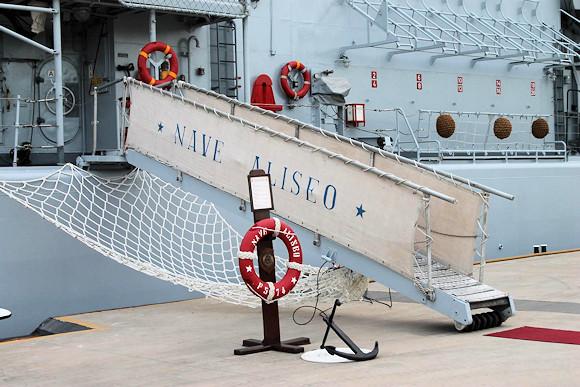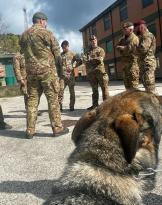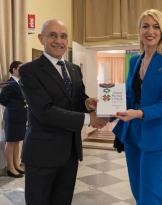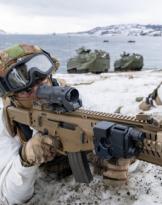"... the fighting flag is unfurled, fastened, waving in the first sun like a roar of liberation. [...] On board the ships, the sailor greets the flag that rises and falls, and interrupts all work, and it turns out, and stands at attention: every morning and every evening. These are sacred moments. But this is something more: it is the flag of combat, it is as if the ship is rearing on the antenna its life itself, it is as if the divine spirit of the Fatherland rose to bless and protect". - (Arnaldo Fraccaroli - war correspondent, from the edge of the Quarto explorer).
From its mooring place at the Mar Grande Naval Station of Taranto, also for the frigate missile launchers Aliseo of the Navy, the ceremony begins for the last ammaina bandiera. On the notes of the national anthem, intoned by all the soldiers present with shining eyes, the mind and heart veiled with emotions, the last ammaina flag for the crew of a unit that ceases its operational life and leaves the team Naval, is filled with a deep symbolic meaning.
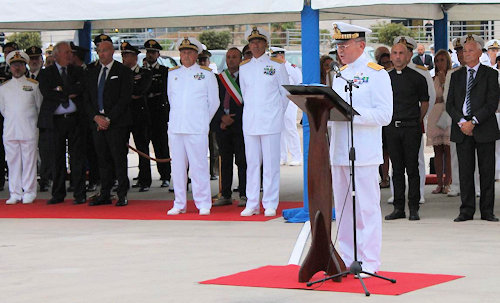 "Navy ships are made of iron, they are made alive by the crews who spend years and years of service on them. When they go into disarming, the symbol that distinguishes them, the flag of Combattimento is kept inside the Shrine of the Banners at the Altar of the Fatherland, to seal the memory and the continuous memory of the Unity", said Admiral Valter Girardelli, Chief of Staff Marina Militare.
"Navy ships are made of iron, they are made alive by the crews who spend years and years of service on them. When they go into disarming, the symbol that distinguishes them, the flag of Combattimento is kept inside the Shrine of the Banners at the Altar of the Fatherland, to seal the memory and the continuous memory of the Unity", said Admiral Valter Girardelli, Chief of Staff Marina Militare.
The national naval flag is the symbol of the country and of the sovereignty of the nation. Affirms the sense of belonging and national identification. Established with a decree of the then Head of State Enrico De Nicola, the 9 November 1947, on the article 1 we read that: "the Navy flag of the Italian Navy is made up of the Italian Tricolore, loaded in the center of the white band, by the heraldic emblem of the Navy, representing the coats of arms of the maritime republics (Venice, Pisa, Genoa, Amalfi) and crowned with a crown turreted and rostrata".
The need for a coat of arms on the Tricolor to be lifted on ships was born from a reason still not known today: during navigation, the Italian flag "unadorned" could have generated misunderstandings, as compliant under the banner of the Mexican Navy.
Respect for the flag, the observance of the customs regarding its use, its exposure and conservation are part of the naval ethics. In the harbor, military ships raise the flag, including the bowsprit at the 8.00 and the ammainano at sunset. They hoist the flag on the stern auction at the entrance and exit of the ports, especially abroad and on the occasion of the ceremonies.
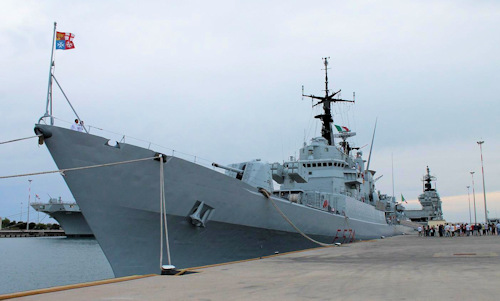 The "Navy Jack" or the bompress flag is the one that the warships raise at the end of the bow, at the bowsprit tree, when they are in port or when they are coming out or entering from it and, when they are at anchor at the he founds in the bay. The "jack" rises and falls at the same time as the naval flag.
The "Navy Jack" or the bompress flag is the one that the warships raise at the end of the bow, at the bowsprit tree, when they are in port or when they are coming out or entering from it and, when they are at anchor at the he founds in the bay. The "jack" rises and falls at the same time as the naval flag.
The flag-raising is performed quickly, the flag ammaina is made at sunset slowly, and ends with the "raised" of the same. Both performed in the presence of an officer and the unit commander. During the ceremonies, all the personnel who are on deck and on the ground near the ship, stop the activities, turn towards the flag and put on the attention.
Even the staff on board a Military Unit that has the flag raised or falling from it, makes it honorable before entering or exiting, briefly putting on the attentions and greeting militarily towards the flag. The list of habits on the use of the flag on board could continue.
Made of fine fabrics decorated with hand embroidery, it is delivered by the youngest officer of the crew to the commander of the unit at the beginning of the operating life, to be then guarded on board, with special care, in a prestigious suit located in the proximity of the commander's cabin.
The fighting flag is not only a symbol for the men and women of a ship's crew, it is also the "soul" of that ship that will live forever and will keep all the moments of life lived together on board.
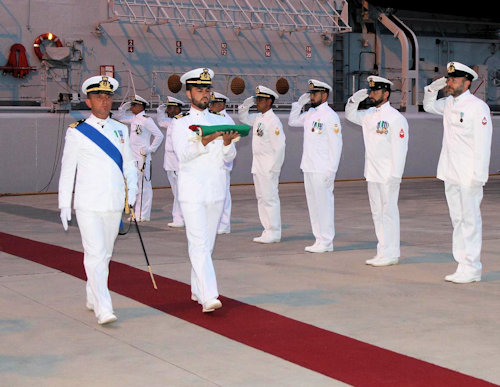 Another piece of the history of the Navy is put to rest and not forgotten: Nave Aliseo, is the 5 ° of the eight frigates of the class Mistral, which are named after the winds coming from the Southeast and Northeast, blowing on the Mediterranean Sea. The "constant" character of these winds has inspired the motto of unity: "constans et indomitus".
Another piece of the history of the Navy is put to rest and not forgotten: Nave Aliseo, is the 5 ° of the eight frigates of the class Mistral, which are named after the winds coming from the Southeast and Northeast, blowing on the Mediterranean Sea. The "constant" character of these winds has inspired the motto of unity: "constans et indomitus".
Set the 26 on May 1981 in the Riva Trigoso Shipyards, launched the 29 1982 on October and delivered the 7 1983 on September. It is the 3 ° vessel in the history of MMI that bears this name. The first in chronological order was a tug that remained in service from 1916 to 1920. The most famous was the spare torpedo boat of the class "Cyclops" delivered in the 1943, put in disarmament in the 1949. The most significant event for the torpedo boat took place under the command of the frigate captain Carlo Fecia di Cossato in September of 1943, when he attacked and sank 10 small German units, outside the port of Bastia, rescuing the survivors who remained among the waves. A copy of the report of this action is displayed in the official upper corridor of theAliseo.
Designed with specific predispositions for the contrast of submarines, over the years it has proved capable of fulfilling many missions such as: defense of other major Military Units of strategic interest from possible air and naval threats, control and interdiction of areas and lines of maritime traffic, contrast to illicit trafficking with Embargo Operations, search and rescue of boats in difficulty. Among the most important activities carried out by the last unit Aliseo who bear this name from 1983, deserve a mention: the Constans Vigilans and Mare Nostrum Operations, to patrol the open sea areas affected by migratory flows from the North African coast to the national territory and to provide relief when needed. The Unit has been able to provide Command and Control Capability to Small-scale Staff, including Multinationals (for one month hosted the Command of NATO's Second Counter Measures Group of Nations); operated 2 helicopters (AB 212) with the security and security teams, boarding or pickers of the Brigade Marina San Marco.
Ship Aliseo the 7 September 2016 has been placed in RID (Reduced Availability Table). Its assignment port is Taranto.
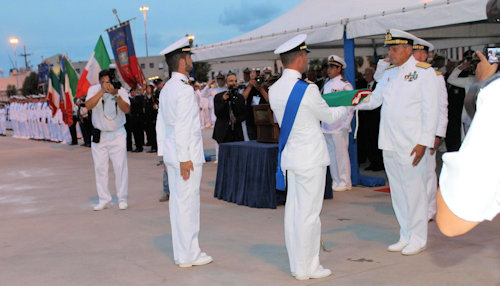 The event of the last ammain flag of 'Aliseo aroused an acute reflection, which resulted in a meeting chaired by the Chief of Staff of the Navy Valter Girardelli, on the relationship between the Navy and the Land of Puglia, before the solemn ceremony took place. The ultra-secular presence of the armed force in the area translates into important naval bases: it represents a factor of significant impact on the historical, social, economic and cultural reality of the area. A large number of excellence of the Navy is concentrated on this territory. There is a significant presence both in terms of quality and quantity of components of the naval team: 6 FREMM (Multi Mission Frigates) will be assigned to the Naval Base of Taranto, two in a short time including Nave Carabiniere and two U212 submarines. Subsequently, a new amphibious ship (LHD), a new supplier (LSS) and part of the new patrol vessels (PPA) will also be assigned. At the Military Naval Arsenal are underway, the stops of Programmatic Progressive Modernization of many units. Naval maintenance activities for Ship are also foreseen Cavour, whose stop will be significant for the work necessary to adapt the unit to the JSF aircraft. The Navy is present on the territory with the Officers' School, Military Hospital Center which is also opening up to the civil population (it has an efficient hyperbaric center and a modern transfusion center), the Aragonese Castle etc. The exaltation and the revaluation of the maritime tradition of the area sees in the investment of the sea an opportunity with a positive impact on the territory.
The event of the last ammain flag of 'Aliseo aroused an acute reflection, which resulted in a meeting chaired by the Chief of Staff of the Navy Valter Girardelli, on the relationship between the Navy and the Land of Puglia, before the solemn ceremony took place. The ultra-secular presence of the armed force in the area translates into important naval bases: it represents a factor of significant impact on the historical, social, economic and cultural reality of the area. A large number of excellence of the Navy is concentrated on this territory. There is a significant presence both in terms of quality and quantity of components of the naval team: 6 FREMM (Multi Mission Frigates) will be assigned to the Naval Base of Taranto, two in a short time including Nave Carabiniere and two U212 submarines. Subsequently, a new amphibious ship (LHD), a new supplier (LSS) and part of the new patrol vessels (PPA) will also be assigned. At the Military Naval Arsenal are underway, the stops of Programmatic Progressive Modernization of many units. Naval maintenance activities for Ship are also foreseen Cavour, whose stop will be significant for the work necessary to adapt the unit to the JSF aircraft. The Navy is present on the territory with the Officers' School, Military Hospital Center which is also opening up to the civil population (it has an efficient hyperbaric center and a modern transfusion center), the Aragonese Castle etc. The exaltation and the revaluation of the maritime tradition of the area sees in the investment of the sea an opportunity with a positive impact on the territory.
With the deposition of the fighting flag and the cancellation of the roles from the military ship of the Fregata Aliseo, also continues, the process of downsizing the Navale fleet of MMI. With the program of the so-called "Naval Law", a process of redevelopment and specialization of the MMI's operational activity has also begun.
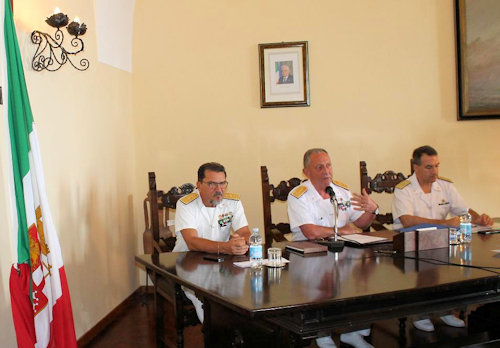 Admiral Girardelli, the financing secured with the latest naval law is sufficient to ensure the proper modernization of the naval instrument given the commitment of the Navy in the Blue Economy and the objective of improving the dual capabilities of the fleet?
Admiral Girardelli, the financing secured with the latest naval law is sufficient to ensure the proper modernization of the naval instrument given the commitment of the Navy in the Blue Economy and the objective of improving the dual capabilities of the fleet?
In the technical evaluation of the modernization foreseen by the law of stability of 2014, which provided for 5,3 billions of euros, reference was made to the 1 ° renovation and modernization intervention. Funding was provided for 7 patrol boats, a landing unit, a logistic support supply, and two support units for underwater operations. Already in that text it is specified that a further reorganization is needed with a new financial, other resources are needed for other operational lines such as minesweepers, submarines etc. In the 1 article 140 of the 2017 Stability Law, a further allocation is foreseen [...] if the economic situation of the country seen the crisis of the last years will improve, will allow to anticipate the events, and is what the Armed Forces wishes [ ...].
All the new units will be environmentally friendly, the use of Biofuel is envisaged, and the possibility of using liquid gas propulsion is not excluded.
The downsizing and redevelopment of the naval fleet commits the Navy into two important sectors: the development of the Blue economy and the use of the "Dual Use" capacity.
Because of the strategic position that Italy occupies in the Mediterranean Sea, the role of MM must necessarily be primary. For Italy, the sea plays a key role: the economic system draws power from the sea. From the data provided to the 1 ° Summit on the Blue Economy, the Mediterranean Sea represents the 1% of the surface of the oceans, through it travels the 19% of the world traffic and in general the 30% of the oil one. In Europe, through the Mediterranean Sea reaches 65% of energy resources. The geopolitical crisis in North Africa, the Middle East and Turkey puts the security of the Mediterranean at risk and therefore all the activities that take place in this sea. Despite the terrorist threat and political instability, the waters of the "Mare Nostrum" continue to be safe due to the naval fleet of the Navy and the Allies, which, as envisaged by the Blue Economy itself, counteract the illicit maritime traffic, the cyber threats terrorism and marine pollution to maritime domination
With regard to dual capabilities, all naval units to fulfill their military tasks are designed with logistic self-sufficiency, rapidity of movement, flexibility of use and the ability to provide multiple types of services, both direct and indirect, to the community.
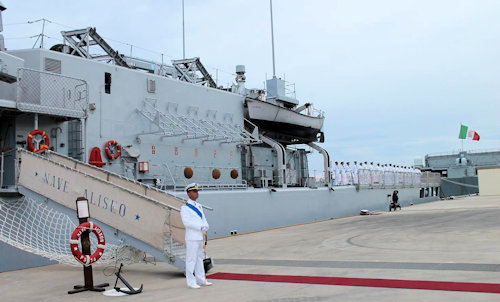 At the solemn ceremony of the disarming of Nave Aliseo, in the presence of CSMM team admirer Valter Girardelli, of the Commander in Chief of the Naval Admiral Team Squad Donato Marzano, Lieutenant of the Ship Luca Gullotti, Commander of Ship Aliseo, in his speech addressing his crew, he praised their effective collaboration, highlighting the intense activity carried out on board the frigate: "The ceremony of the last Ammaina Bandiera arouses in every sailor a feeling of melancholy, a feeling that for a sailor is difficult to explain [...] along with the ship is as if a part of his life is put to rest [...] I am proud of to have been your commander [...]."
At the solemn ceremony of the disarming of Nave Aliseo, in the presence of CSMM team admirer Valter Girardelli, of the Commander in Chief of the Naval Admiral Team Squad Donato Marzano, Lieutenant of the Ship Luca Gullotti, Commander of Ship Aliseo, in his speech addressing his crew, he praised their effective collaboration, highlighting the intense activity carried out on board the frigate: "The ceremony of the last Ammaina Bandiera arouses in every sailor a feeling of melancholy, a feeling that for a sailor is difficult to explain [...] along with the ship is as if a part of his life is put to rest [...] I am proud of to have been your commander [...]."
CSMM, Admiral Valter Girardelli, in his speech stressed that: "The frigates of the Maestrale class for the promptness of intervention thanks to the operation of their crews have allowed the armed force and the nation to gain more and more credibility in the allied and international field. Even today the naval units of the Mistral class are engaged in operational activities of coalition and in international missions [...] Nave Aliseo is the 5 ° of the class and is the 2 ° to be placed in disarmament. In fact a progressive change is taking place in the units of the Mistral class that leave the operational service. The new FREAMES of the Bergamini class will enter and, after their entry into the naval team, will be assigned to the naval bases of Taranto and La Spezia. This rotation allows the Armed Force to reduce the number of personnel on board using modern technologies used on board. And from the economic point of view the new FREMMs are built with criteria that ensure lower management and maintenance costs [...]".
After the reading of the device disarming the vessel and after the sailor's prayer, the ship's flag Aliseo it was last moved to the notes of the national anthem.
"The highest and noblest sign of our country, a banner that has consecrated the unity at the service of the Institutions throughout its working life, will be disembarked to be kept in the respective bonnet".
Part of the crew deployed on the flight deck, abandoned the Unit to position themselves in a corridor through which the TV commander Gullotti with a slow and rhythmic step, accompanied by 21 cannon volleys heading towards the CSMM, handed over the combat flag intended for the Museum of the flags of the armed forces, inside the Altar of the Fatherland, a symbolic place of national memories.

